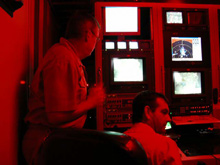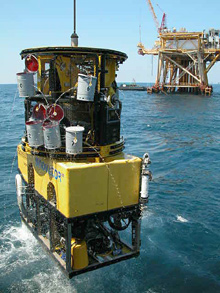Getting Up-close and Personal Underwater
September 17, 2003
Taconya D. Piper
NOAA Office of Ocean Exploration
![]() Video of the diversity of marine life hidden beneath oil platforms. (mp4, 3.4 MB)
Video of the diversity of marine life hidden beneath oil platforms. (mp4, 3.4 MB)
With the development of ROV technology, underwater research has taken us deeper than we could have ever imagined. ROVs are taking us places and showing us things scientists from even a generation ago would not have thought possible. Today, though, we took a "step back" technologywise, and donned scuba gear to get up-close and personal with the underwater world.
An ROV has many advantages over scuba. An ROV can dive deeper, stay under for long hours, and doesn't run the risk of injury or worse like people do. The beauty of scuba, however, is that scientists get a personal view of the environment they are sampling, and can touch and observe organisms in their natural habitat before they are collected for research.
Five members of the science party donned scuba gear today, left the confines and safety of the ship and ventured to the Apache oil platform to collect sponge and coral samples from the jackets (legs) of the platform. Their dive preparations began two days ago. As the team conducted ROV operations, the scuba divers placed their gear in the main lab, checked their gauges and hoses, and made sure they had everything they needed. Chief Scientist John Reed reminded them to drink plenty of fluids and to check and recheck their gear.
When one scuba dives, one word is key: Safety. When you are dealing with human life, a single mistake can prove costly. Several pre-dive meetings were held to discuss proper scuba operations. John Reed insisted that the divers conduct themselves safely and professionally and that they knew and followed all procedures exactly. Don't get me wrong -- scuba diving is fun, especially when you are actually getting paid to do it! Nevertheless, it can be very dangerous if you don't follow the rules.
I stood on the weather deck of the Ron Brown and watched as the divers methodically loaded the small boat that would take them to the platform. Scuba requires a "ton" of equipment. Each diver had his or her mask, snorkel, fins, oxygen tank, vest with hoses for the regulator and tank, cameras, and other items. I imagined how excited they must be to "get wet" and be one with the marine environment. I secretly wished I was one of them.

Captain John Wilder of the NOAA Ship Ronald H. Brown checks out operations in the ROV van. Click image for larger view.
Scuba diving for science is not an easy job, and it is definitely not for everyone. You certainly just don't hop in the water and dive. To participate in a dive like this, one must first take many classes and receive several certifications. A good diver pays close attention to detail and must work well as part a team. Diving is rarely, if ever, a solo pursuit.
Most of the time, divers are paired up (occasionally there is a trio) as part of the "buddy system." You learn to stay aware of your buddy's whereabouts at all times, and leaving your buddy behind or "losing" him or her in the water is very poor form.
Our divers paired up and slowly descended to a depth of 90 ft, where they collected sponges, corals, and anemones along the jackets of the oil platform. They also took some video and photographs of the site and the resident organisms.
About 90 minutes after the scuba divers left on their underwater adventure, there was an announcement on board: "The rhib will be alongside in 3 minutes." The rhib is the small boat that transported the divers to the oil platform.
I grabbed my camera and hurried to the deck to get the divers' impressions of their experience. Their excitement was contagious. They were all smiles, telling everyone what they saw and how wonderful it was to be in the water. They confirmed that the actual dive was just as exciting as I had imagined it would be.
Even though ROV technology can take us underwater further, faster and for longer, most every ocean explorer longs to experience the wonders of the deep through their very own eyes. That's why it's safe to say that the "pioneer technique" of scuba diving is here to stay.
Sign up for the Ocean
Explorer E-mail Update List.
























